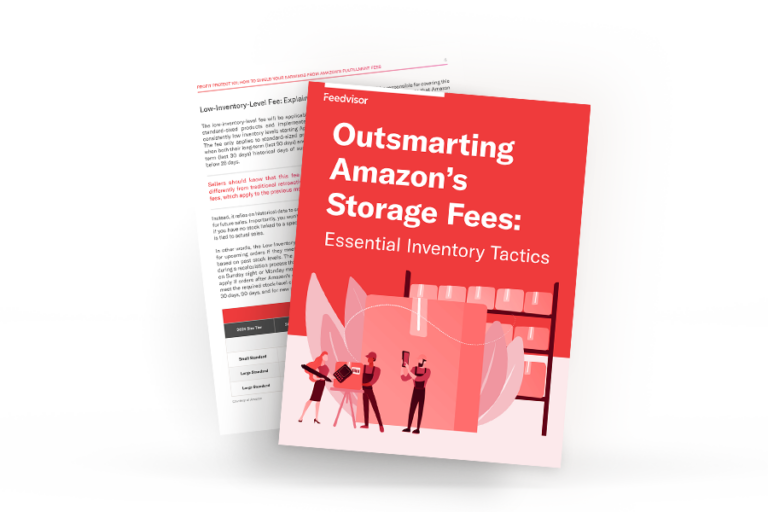Resources - Blog
The 5 Best Ways to Protect Your Profits From Storage Fees

Amazon fulfillment fees can be frustrating for sellers’ bottom lines. Research shows sellers pay 20-35% in FBA (Fulfillment by Amazon) fees, which cover storage and other costs.
In 2024, sellers face an even bigger challenge as Amazon implements additional fulfillment fees, which can dig deeper into profits.
Let’s discuss Amazon’s most recent fee updates and the actions you can take to minimize fulfillment costs and safeguard your earnings.
Amazon’s Fulfillment Fees: A Bigger Focus in 2024
In 2023, Amazon achieved its quickest global delivery speeds for Prime members by prioritizing regional fulfillment centers, marking its fastest shipping speeds to date.
For 2024, Amazon is doubling down on its efforts to improve supply chain and inventory management. Its goal is to enhance operations by providing teams with precise insights into incoming inventory and aligning it with regional customer demands for a more streamlined and responsive process.
Amazon is reinforcing its distribution centers by introducing new inventory fees and features to motivate sellers to master their inventory management. Notably, Amazon has introduced a new low-inventory-level fee and improved its inventory reporting.
Current research indicates that Amazon now deducts $0.45 in fees from every third-party sales dollar. A significant portion of these costs comes from fulfillment fees, with FBA fees accounting for up to 35% of a seller’s total fees.
Unfortunately, fulfillment costs cannot be avoided. But there are ways for sellers to prevent these costs from increasing and affecting their profits.
How to Avoid Fulfillment Fees From Piling Up
Fulfillment fees can increase based on various factors. Amazon applies performance metrics to indicate how well sellers maintain their inventory levels, product listings, and more. Learn what these metrics are, what you want to achieve for each, and tips to ensure you’re paying the floor amount in fulfillment fees.
Monitor Inventory Metrics
Amazon recommends having sufficient inventory to cover 30 to 60 days of anticipated sales. This is represented by the metric “Days of Inventory,” which is calculated by dividing the current inventory by daily units sold. This forward-looking metric compares the current inventory level to the historical average sales velocity.
On the other hand, Days of Supply is a backward-looking metric. Instead of considering current inventory, it examines the historical average units on hand, dividing it by the average daily units shipped (which, over time, is nearly identical to the average units sold).
Your sell-through rate measures how quickly your inventory is sold within a specific period. It is expressed as a percentage and represents the ratio of units sold to the total inventory available. Knowing this metric helps you manage inventory better, ensuring you don’t have excess stock that will incur additional storage fees.
To prevent a Storage Utilization Surcharge, sellers should monitor their Storage Utilization ratio to ensure it remains below 26 weeks. This ratio is based on storage volumes rather than units. If the ratio runs high, the most effective solution is to expedite sales, optimizing the use of storage space.
Improve Your IPI Score
Your Amazon IPI score measures your efficiency and productivity in managing your FBA inventory. IPI scores range from 1 to 1000, and the higher, the better. Amazon wants to motivate sellers to stock the ideal product quantities based on demand so that Amazon can optimize space at its FBA warehouses.
The current minimum IPI score threshold that all sellers must meet to avoid paying higher storage costs (and limited FBA storage space) is 400. As Amazon can change this threshold at any time, it’s best to aim for an IPI of at least 500.
There are a few ways that sellers can increase their IPI score to reduce storage costs:
- Improve your 90-day rolling sell-through by keeping enough stock to cover 30 to 60 days of forecasted sales.
- Remove excess and aged inventory in a fulfillment center before it reaches 365 days to avoid paying long-term storage fees and lowering your IPI score.
- Fix listing issues immediately to ensure that all your items stored in Amazon warehouses are sellable with active product listings. If any listings are flagged for issues or showing as inactive, those items become “stranded inventory,” which lowers your IPI score.
Optimize Product Listings
If you have stranded inventory, you are paying storage fees on products with no profitability, as those products are deemed unsellable to customers. Stranded inventory is typically caused by issues with the product’s listing.
It’s important to fix listing issues as quickly as possible to avoid paying higher storage fees and missing valuable sales. Check your stranded inventory percentage regularly so you are aware of any problems with your listings and can address them immediately before incurring extra fees and penalties.
Optimize Inventory Velocity Using Repricing Technology
Maintaining healthy inventory levels is another way to avoid extra fees. The goal is to optimize your inventory velocity in near real-time to avoid stock issues. But it can be challenging to respond to market conditions manually and forecast how your inventory levels will fare in the future. Responding to frequent price changes and varying consumer demand requires more than a manual approach.
This is where Feedvisor’s inventory-aware repricing technology can do the heavy lifting for you. It predicts consumer demand, shifts in your selling rate, and identifies unforeseen issues that may be missed manually.
Feedvisor’s AI-powered repricer provides invaluable information on your inventory health and turns this data into actionable strategies that it automatically implements to optimize inventory velocity. The result: Sellers can fine-tune their inventory velocity, prevent inventory issues, and avoid paying more in storage fees.
Manage Your Parent ASINs
If you encounter significant stocking issues with certain products, consider placing them in a slower moving “parent” category to gain some breathing room.
Conversely, if a product is dragging down an entire category and you wish to avoid the low-inventory-level fee for each variation, it may be wise to remove the ASIN from that parent category to prevent negative repercussions on the others.
Final Thoughts
In a landscape where every fee deduction impacts your bottom line, safeguarding your earnings has never been more crucial. Amazon’s introduction of the new low-inventory-level fee and enhanced reporting emphasizes the need for proactive strategies to protect your profits.
Successfully navigating the intricate landscape of Amazon’s fulfillment fees requires a strategic approach, harnessing the power of cutting-edge AI-driven repricing technology. See it in action with a free, 14-day trial of Feedvisor’s industry-leading repricing platform.


